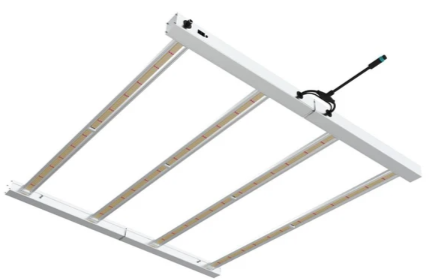At the same time, it’ll be easier for you to find a top-rated 400W LED grow light that suits your plants’ needs. No need to waste your time searching elsewhere, below are the top products that can keep your plants healthy.
LED stands for light-emitting diodes. LED grow lights have come down in price significantly and home growers everywhere are starting to make the switch to solely using them as their lighting option.
These lighting systems produce extremely low heat, come ready to plug-and-play, and can produce high yields with incredible energy efficiency
HIDs require a reflector and ballast, LED grow lights do not. They can last for decades, whereas HID bulbs will often need to be replaced every couple of years. But, one of the main reasons LED grow lights are regarded as the best is due to the spectrum they produce.
The best LED grow lights all have a few things in common - uniform spectrum, light intensity, efficiency, high-quality components, and safety and reliability.
Spectrum
A proper, well constructed LED grow light will have a uniform spectrum. So if you have 4 plants under your light, they all get the same spectrum.
We’ve already touched on the spectrum a bit, but it’s important to reiterate that the best spectrum consists of not just red and blue light, but also infrared (IR) and Ultraviolet (UV).
Full spectrum LEDs allow you to grow from seed to harvest with the same light, as opposed to having to replace bulbs or use different grow lights for veg and flower.
Is the spectrum constructed of single-wavelength ‘mono’ diodes, full-spectrum white diodes, COBs, or combinations of these? Do you prefer one over the other?
- Spectrums constructed of targeted single-wavelength diodes are becoming less common since they are not as energetically efficient, have lower PPFD, lack canopy penetration, and plants can appear purple underneath them. This is more common with budget lights.
- White light full-spectrums (white diodes or COBs) commonly range from 3000K to 4000K. 3000K is best for flower, 3500K is best for full-cycle, and 4000K is best for veg. Less common.
- Enhanced white light spectrums (base of white light enhanced with UV, blue, red, and/or far-red diodes) are a good option since they provide all of the useful wavelengths that plants absorb and utilize. 3500K with added 660nm red is a popular spectrum. Increasingly common and ideal.
- Increased blue = ideal for veg (4000K white light spectrum)
- Increased red = ideal for flower (3000K or 3500K white light spectrum)
- Does the fixture offer spectrum tuning between the growth and flower stage? While not entirely necessary, this can help save energy while delivering an ideal spectrum during veg and flower.
The more light your LED actually gives off, the bigger your yields (for the most part). So, any high end led grow lights need to be incredibly powerful.
What is the PPF of the fixture? Is this a sufficient amount of light considering the wattage draw and efficacy?
~1700-2400 umol/s per 5’x5’+ area
~1300-1700 umol/s per 4’x4’ to 5’x5’ area
~600-1300 umol/s per 3’x3’ to 4’x4’ area
~300-600 umol/s per 2’x2’ to 3’x3’ area
Is there a PAR map available of the fixture? Are the PPFD readings sufficient for your stage of growing? How uniform are the readings across the footprint (spotlight vs even footprint)?
- Can you calculate the average PPFD using the PAR chart? Average PPFD = Sum of PPFD readings/number of PPFD readings.
- Is the average PPFD sufficient for your plant’s stages of growth? Veg: 300-600 umol/m2/s, Flower: 600-1000 umol/m2/s or more.
In general, LED grow lights are very efficient. But, the best LED grow lights will maximize your efficiency. Most importantly, they operate at a high level, produce higher power, and maintain a low cost to run.
How many watts does the fixture draw from the wall?
To determine this, view the fixture specifications. Be aware that the number in the title or name of the light likely doesn’t represent actual wattage. It may be a model number, total LED wattage, or an HPS wattage equivalent.
Consider about 35 watts per square foot of growing space for planning purposes. 30 watts to 44 watts is a common range. More efficient fixtures may use fewer watts per square foot. Higher intensities per square foot are possible with more efficient fixtures and a higher overall wattage draw. Wattage does not equate to light output so do not use the wattage draw to determine how ‘powerful’ a fixture might be.
Dissipates heat better to extend its lifespan
Enlite Sulis LED Consumes and wastes less energy
Promotes optimal growth for plants’ photosynthesis
Releases minimum heat even after working for 17 hours day
Cons:
The brightness doesn’t last that long
The light beam is too narrow to cover other plants under it
Mammoth Lighting is Budget-friendly
Includes a handy timer
Boosts their process of photosynthesis and growth
Performs efficiently with a longer life
Consumes low power with high luminous LEDs
Cons:
Gets a little too hot to touch
Creates a noise on the power lines


























